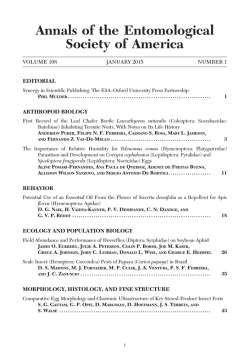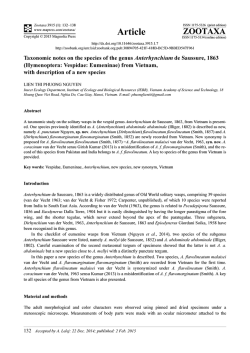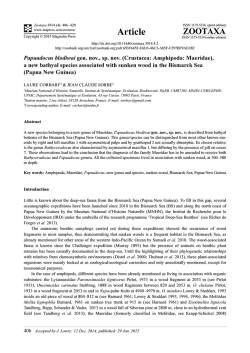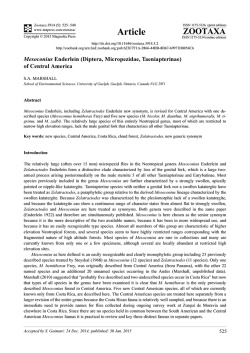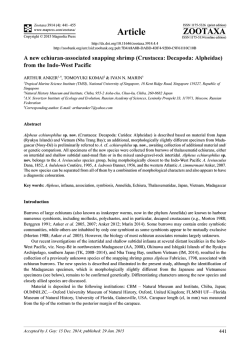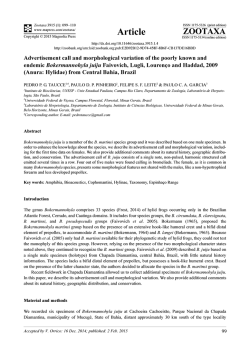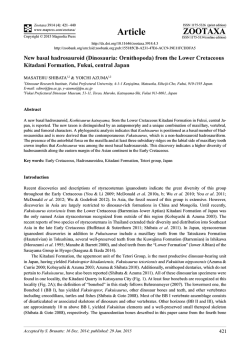
Preview - Magnolia Press
Zootaxa 3914 (3): 245–274 www.mapress.com /zootaxa / Copyright © 2015 Magnolia Press Article ISSN 1175-5326 (print edition) ZOOTAXA ISSN 1175-5334 (online edition) http://dx.doi.org/10.11646/zootaxa.3914.3.2 http://zoobank.org/urn:lsid:zoobank.org:pub:37289B14-D589-429D-9C02-8860F13B18AD The species of Colletinae (Hymenoptera: Colletidae) in the Brazilian state of Minas Gerais RAFAEL R. FERRARI1 & FERNANDO A. SILVEIRA2 Departamento de Zoologia, Instituto de Ciências Biológicas, Universidade Federal de Minas Gerais. Caixa Postal 486, 30123-970 Belo Horizonte, Minas Gerais, Brazil. E-mails: [email protected]; [email protected] Abstract The Brazilian state of Minas Gerais is a species-rich territory about as large as France, which houses the headwaters of some of the most important rivers in Brazil, as well as a variety of phytogeographic domains, with a poorly known insect fauna. Here, a synopsis of the bee species included in the genera Colletes Latreille, 1802 and Rhynchocolletes Moure, 1943 (Colletidae: Colletinae) occurring in this state is presented, including synonymies, diagnoses, redescriptions and identification keys to females and males of the eight recognized species, including one described as new. These species are Rhynchocolletes albicinctus Moure, 1943; Colletes altimontanus Ferrari & Silveira sp. nov.; C. argentinus Friese, 1908 stat. rev., C. meridionalis Schrottky, 1902; C. ornatus Schrottky, 1902; C. petropolitanus Dalla Torre, 1896; C. rufipes Smith, 1879; and C. rugicollis Friese, 1900. Colletes extensicornis Vachal, 1909 is here proposed to be a junior synonym of C. meridionalis. Key words: bees, Colletes, Rhynchocolletes, Neotropics, taxonomy Introduction The classification of Colletidae has changed considerably since the seminal paper by Michener (1944) on the phylogeny and classification of the bees. Here, the subfamily Colletinae is considered in a narrow sense, following authors such as Silveira et al. (2002) and Almeida & Danforth (2009), and corresponding to the tribe Colletini in classifications such as those of Michener (1944, 1989, 2007), Engel (2001), Moure & Urban (2002), Melo & Gonçalves (2005) and Moure et al. (2007). As such, Colletinae comprises Colletes Latreille, 1802, a species-rich and worldwide genus, and related South American genera. The number of genera considered in Colletinae has also been subject to controversy. Michener (1944) considered it to comprise only of Colletes, but later, he recognized one additional genus in the group—Mourecotelles Toro & Cabezas, 1978 (Michener 1989, 2000, 2007), which was subdivided into three subgenera: Mourecotelles s.str., Hemicotelles (Toro & Cabezas 1977), and Xanthocotelles (Toro & Cabezas 1978). This arrangement, however, has not been unanimously accepted, with Moure & Urban (2002) recognizing six genera in Colletinae, whereas Moure et al. (2007) recognized four genera. Here, we follow the generic classification adopted by Moure et al. (2007), with two of their genera being included in the scope of this revision: Colletes and Rhynchocolletes Moure, 1943. Colletes is a cosmopolitan taxon, only absent in the Australian region and Antarctica (Michener 2007), and including an estimated 700 species (Kuhlmann et al. 2009). In the Neotropics, it is represented by 107 valid names (Moure et al. 2007). As pointed out by Michener (2007) and Kuhlmann et al. (2009), two morphological synapomorphies support the monophyly of Colletes: (i) the “S”-shaped second recurrent vein of the hind wing and (ii) the basal portion of propodeum limited posteriorly by a carina (or sharp change in slope) and divided into pits by longitudinal carinae. The last comprehensive study to include the Brazilian fauna of Colletes was part of Schrottky’s (1902) essay on Brazilian solitary bees, where five species were recognized in this country. A century later, Silveira et al. (2002) recorded 12 species for Brazil. Two of these, C. albicinctus (Moure 1943) and C. Accepted by C. Rasmussen: 11 Dec. 2014; published: 28 Jan. 2015 245 Acknowledgments We wish to thank the curators listed in “Material and methods”, for the loan of specimens; Alexsander A. Azevedo for help in the lab and in the field; Prof. Adalberto J. Santos, from the Laboratory of Arachnology at department of zoology, Universidade Federal de Minas Gerais, for allowing us to use the photographic equipment under his care (provided by the project INCT/HYMPAR/SUDESTE); Igor R. Coelho, who photographed the lectotype of C. rugicollis shown in Figure 17; and Kelli Ramos for making data on the MZUSP catalogue, available. We are grateful to two anonymous reviewers for comments and suggestions that helped to improve the first version of this manuscript. This paper was benefited by financial support by the Minas Gerais State Funding Agency (FAPEMIG). Rafael R. Ferrari thanks the Brazilian council for development of research and technology (CNPQ) for a scholarship. References Almeida, E.A.B. & Danforth, B.N. (2009) Phylogeny of colletid bees (Hymenoptera: Colletidae) inferred from four nuclear genes. Molecular Phylogenetics and Evolution, 50, 290–309. http://dx.doi.org/10.1016/j.ympev.2008.09.028 Cockerell, T.D.A. (1905) Some American Hymenoptera. Entomological News, 16, 9–10. Cockerell, T.D.A. (1917) Descriptions and records of bees. Annals and Magazine of Natural History, 20, 436–441. http://dx.doi.org/10.1080/00222931709487033 Dalla Torre, C.G. de (1896) Catalogus Hymenopterorum, Vol. 10, Apidae (Anthophila). Engelmann, Leipzig, viii + 643 pp. Engel, M.S. (2001) A monograph of the Baltic amber bees and evolution of the Apoidea (Hymenoptera). Bulletin of the American Museum of Natural History, 259, 1–192. http://dx.doi.org/10.1206/0003-0090(2001)259<0001:amotba>2.0.co;2 Eversmann, E. (1852) Fauna Hymenopterologica Volgo-Uralensis. Bulletin de la Société Imperiale des Naturalists de Moscou, 25, 1–137. Friese, H. (1900) Neue Bienenarten Süd –Americas´s. Entomologische Nachrichten, 26, 180–184. Friese, H. (1908) Die Apidae (Blumenwespen) von Argentina nach den Reisenergebnissen der Herren A. C. Jensen–Haarup und P. Joergensen in den Jahren 1904–1907. Flora og Fauna, 10, 1–94. http://dx.doi.org/10.5962/bhl.title.14257 Friese, H. (1921) Nachtrag zur Bienenfauna von Costa Rica. Stettiner Entomologische Zeitung, 82, 73–98. Gray, J.E. (1850) On the Species of Anomiadae. Proceedings of the Zoological Society of London, 17, 113–125. Holmberg, E.L. (1886) Viajes al Tandil y a la Tinta, 2nd Parte, Zoología, Insectos. I. Himenópteros- Hymenoptera. Actas de la Academia Nacional de Ciencias de la República Argentina en Córdoba, 5, 137–184. Kuhlmann, M., Almeida, E.A.B., Laurenne, N. & Quicke, D.L.J. (2009) Molecular phylogeny and biogeography of the bee genus Colletes Latreille, 1802 (Hymenoptera: Apiformis: Colletidae), based on mitochondrial COI and nuclear 28S nuclear sequence data. Insect Systematics & Evolution, 40, 291–318. http://dx.doi.org/10.1163/139956009x12475840653733 Latreille, P.A. (1802) Ordre natural des insectes désignés généralement sous le nom d'abeille, Apis Lin. Geoff. In: Latreille, P.A. (Ed.), Histoire naturelle des fourmis, et recueil de mémoires et d'observations sur les abeilles, les araignées, les faucheurs, et autres insects. Théophile Barrois, Paris, pp. 401–438. http://dx.doi.org/10.5962/bhl.title.11138 Linnaeus, C. (1758) Sistema Naturae. Tenth Edition. Laurentii Salvii, Holmiae, 824 pp. Melo, G.A.R. & Gonçalves, R.B. (2005) Higher-level classifications of bees (Hymenoptera, Apoidea, Apidae sensu lato). Revista Brasileira de Zoologia, 22, 153–159. http://dx.doi.org/10.1590/s0101-81752005000100017 Michener, C.D. (1944) Comparative external morphology, phylogeny, and a classification of the bees (Hymenoptera). Bulletin of the American Museum of Natural History, 82, 151–326. Michener, C.D. (1989) Classification of American Colletinae (Hymenoptera, Apoidea). The University of Kansas Science Bulletin, 53, 622–703. Michener, C.D. (2000) Bees of the World. Johns Hopkins University Press, Baltimore, 913 pp. Michener, C.D. (2007) Bees of the World. 2nd Edition. Johns Hopkins University Press, Baltimore, 1016 pp. Moure, J.S. (1943) Notas sôbre abelhas da coleção Zikán (Hym. Apoidea). Revista de Entomologia, 14, 447–484. Moure, J.S. (1944) Apoidea da coleção do Conde Amadeu A. Barbiellini (Hym. Apoidea). Revista de Entomologia, 15, 1–18. Moure, J.S. (1945) Apoidea da Coleção do Conde Amadeu A. Barbielini. II. (Hym. Apoidea). Revista de Entomologia (Rio de janeiro), 16, 394–414. Moure, J.S. (1949) Notas Sobre Algunas Abejas de Tacanas, Tucumán, Argentina. II. (Hymenopt. Apoidea). Revista de Entomologia, 20, 437–460. COLLETINAE IN THE BRAZILIAN STATE OF MINAS GERAIS Zootaxa 3914 (3) © 2015 Magnolia Press · 273 Moure, J.S. (1956) Algumas espécies novas de Colletes do Brasil e do Chile (Hymenopt. – Apoidea). Dusenia, 7, 197–210. Moure, J.S. & Urban, D. (2002) Catálogo de Apoidea da região Neotropical (Hymenoptera, Colletidae). III. Colletini. Revista Brasileira de Zoologia, 19, 1–30. http://dx.doi.org/10.1590/s0101-81752002000100001 Moure, J.S., Urban, D. & Melo, G.A.R. (2007) Colletini Lepeletier, 1841 In: Moure, J.S., Urban, D. & Melo, G.A.R. (Eds.), Catalogue of Bees (Hymenoptera, Apoidea) in the Neotropical Region. Sociedade Brasileira de Entomologia, Curitiba, pp. 677–689. Rasmussen, C. & Ascher, J.S. (2008) Henrich Friese (1860–1948): Names proposed and notes on a pioneer melittologist (Hymenoptera, Anthophila). Zootaxa, 1833, 1–118. Rasmussen, C., Garcete-Barrett, B.R. & Gonçalves, R.B. (2009) Curt Schrottky (1874-1937): South American entomology at the beginning of the 20th century Hymenoptera, Lepidoptera, Diptera). Zootaxa, 2282, 1–50. Schrottky, C. (1902) Ensaio sobre as abelhas solitárias do Brazil. Revista do Museu Paulista, 5, 330–613. http://dx.doi.org/10.5962/bhl.title.9478 Silveira, F.A. (2009) A synopsis of Actenosigynes - new species, possible oligolecty and biogeographic comments. Zootaxa, 2292, 15–24. Silveira, F.A. & Cure, J.R. (1993) High-Altitude bee fauna of southeastern Brazil: Implications for biogeographie patterns (Hymenoptera:Apoidea). Studies on Neotropical Fauna and Environment, 28, 47–55. Silveira, F.A., Melo, G.A.R. & Almeida, E.A.B. (2002) Abelhas Brasileiras: Sistemática e Identificação. Edição dos autores, Belo Horizonte, 253 pp. Smith, F. (1879) Descriptions of New Species of Hymenoptera in the Collection of the British Museum. British Museum, London, xxi + 240 pp. http://dx.doi.org/10.5962/bhl.title.17490 Toro, H. & Cabezas, V. (1977) Nuevos generos y especies de Colletini sudamericanos, segunda parte. Anales del Museo de Historia Natural de Valparíso, 10, 45–64. Toro, H. & Cabezas, V. (1978) Nuevos generos y especies de Colletini sudamericanos, segunda parte. Anales del Museo de Historia Natural de Valparíso, 11, 131–148. Vachal, J. (1904) Voyage de M. G. A. Baer au Tucuman (Argentine). Hymenoptera Mellifera (Familia unica: Apidae). Revue d'Entomologie, 23, 9–26. Vachal, J. (1909) Espèces nouvelles ou litigieuses d’Apidae du haut bassin du Paraná et dês régioons contiguës et délimitation d’une nouvelle sous-famille Diphaglossinae (Hym.). Revue d’Entomologie, 28, 1–70. Westwood, J.O. (1875) Descriptions of some new species of short-tongued bees belonging to the genus Nomia of Latreille. Transactions of the Entomological Society of London, 23, 207–222. http://dx.doi.org/10.1111/j.1365-2311.1875.tb01908.x 274 · Zootaxa 3914 (3) © 2015 Magnolia Press FERRARI & SILVEIRA
© Copyright 2025
